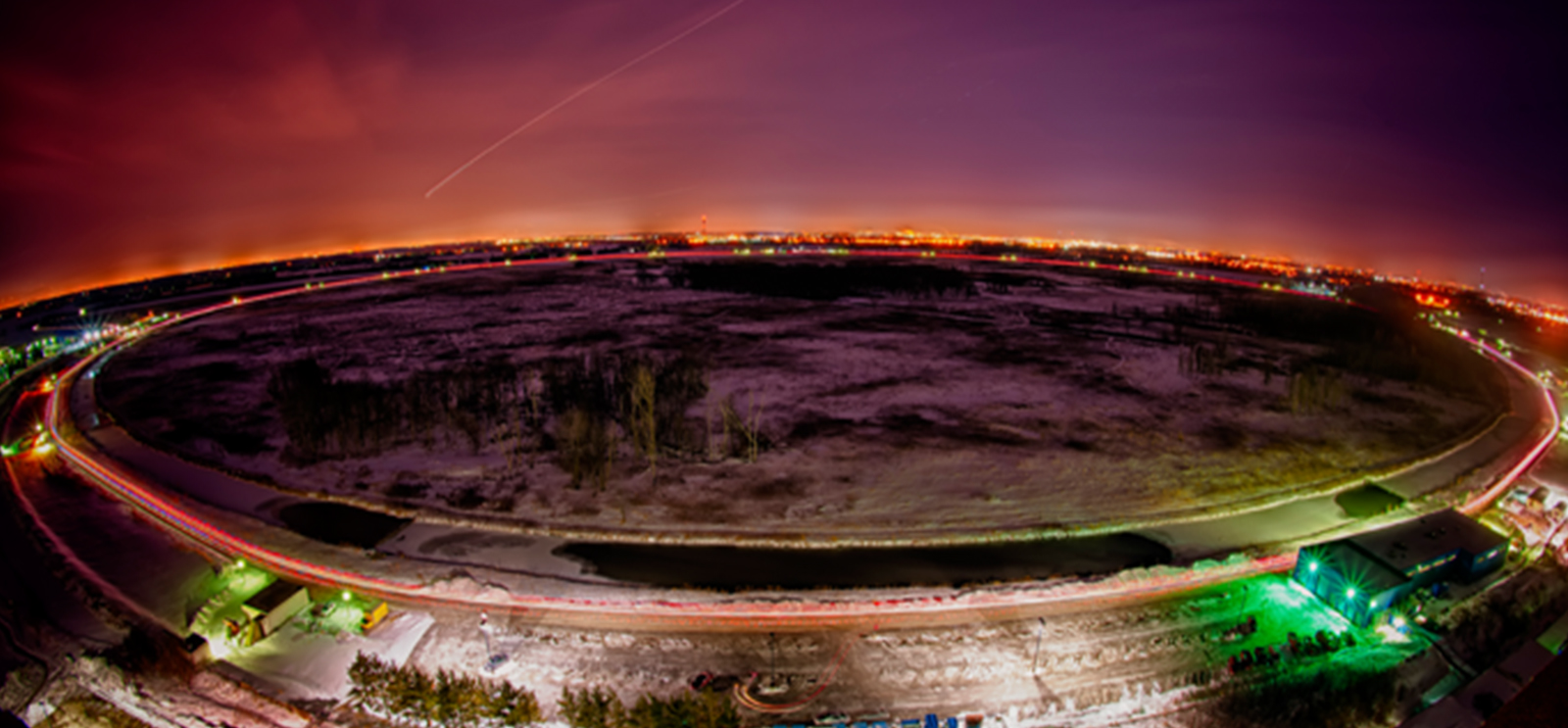
For more than two decades, Fermilab’s particle accelerator Tevatron was a smashing success. (Photo courtesy Fermi National Accelerator Laboratory)
High-energy physics experiments at Fermilab’s groundbreaking Tevatron have run their course.
After 26 years of smashing together subatomic pieces, researchers at the University-run Fermi National Accelerator Laboratory powered down the Tevatron particle accelerator September 30.
Ever since the Large Hadron Collider (LHC), a more powerful accelerator at CERN, began running experiments in 2010, word had spread that the Tevatron’s days were numbered. Then, in early January, a tweet from Harvard physicist Lisa Randall leaked the news that signaled the official end of the once-dominant collider. “Very sad,” Randall wrote on Twitter. “Tevatron will be turned off at end of year.”
The Tevatron’s reign in high-energy research ended almost two years ago. Researchers at CERN, situated on the Franco-Swiss border, used their new collider to break the Tevatron’s energy-collision record in March 2010. The LHC will soon produce collisions with seven times the energy of those achieved by the Tevatron.
Yet the two colliders were complements rather than rivals—LHC collides two proton beams together, while the Tevatron smashed protons into antiprotons—and experiments at one built upon the discoveries at the other. Without the Tevatron, it may even take CERN scientists longer to verify the existence of the Higgs boson, the final particle predicted by the Standard Model of physics, which attempts to explain how everything in the universe works.
So the Tevatron’s closing ceremonies at Fermilab both mourned its loss and celebrated its role in getting high-energy physics this far. “This was all part of the plan,” says Young-Kee Kim, a Chicago physics professor and deputy director of Fermilab. Kim was part of the team that found the top quark in 1995, the sixth and final of the quarks.
Quarks, elementary particles that combine to form protons and neutrons, come in pairs. When Fermilab researchers demonstrated the existence of the bottom quark in 1977, an international race was on to find its counterpart top quark. By then James Cronin, SM’53, PhD’55, professor emeritus in physics and 1980 Nobel laureate, had been leading a group to determine how to generate and study high-energy collisions. “There were five accelerators—in Japan, CERN, Germany, and the United States—whose primary goal was finding the top quark,” Kim says.
After the discovery, the Tevatron continued to lead high-energy physics, finding four baryons (particles made up of three quarks) and the tau neutrino (near-zero-mass particles that travel close to, and possibly beyond, the speed of light). “For quite a while we were really on top,” recalls Kim, “and everybody’s focus was on us.”
Now the responsibility of finding the Higgs boson, the last puzzle piece, falls to the physicists at CERN. Researchers predict they will find the Higgs, which lends mass to all other particles, within the next few years. Meanwhile, Fermilab researchers continue to sift through data collected from past Tevatron experiments for evidence of the Higgs, or for signs that it might not exist after all.
The Tevatron’s contributions reach beyond high-energy physics and into now-routine medical practices. The superconducting magnets used in MRI machines are the same ones required to steer the particle beams around Fermi’s racetrack. In the Tevatron’s early days, those magnets were incredibly expensive to produce—only a few hundred pounds of the required niobium-titanium wire were mined each year. Working with the mining and manufacturing industries, Fermilab scientists and engineers spurred large-scale extraction of the material and as a result made MRIs more affordable.
While scientists at CERN continue research on the high-energy frontier, there is still room for discoveries at Fermilab. The focus will shift to neutrino beams used in fixed-target experiments, and researchers will take advantage of the Tevatron’s now quiet machinery. “There are a total of nine accelerators at Fermilab now,” says Kim. “Four will be shut down, and three of these four will be reconfigured to boost the intensity of the neutrino and muon beams.” Instead of speeding up the particle beams, researchers will work to produce the most particles possible, hoping to observe previously unseen interactions.
This past June Fermilab proposed Project X, a new accelerator complex that could run by 2020. Experiments would use high-intensity neutrino, muon, and kaon beams to probe long-standing questions about matter, energy, space, and time. They would also look for ways to safely run nuclear reactors using accelerators and to reduce the half-life of nuclear waste. “These things have to be studied and researched one by one,” says Kim. “And Project X can do all of these things.”
Ed Blucher, professor and chair in the physics department who has conducted research at the Tevatron, sees the shift in sociological terms. Big collider experiments, like those now happening at the LHC, produce data on several subfields simultaneously. As a result, CERN’s collider draws huge numbers of PhD students and researchers—many Fermilab researchers have already moved there to continue their work. “It’s like a faucet that several people can drink from at the same time.” In contrast, Fermilab’s new experiments are more focused and engage smaller groups of scientists.
Fermilab’s challenge over the next ten to 15 years is to draw researchers and keep them, Blucher says. Yet particle physics can move almost as fast as an accelerated proton beam, and there’s no telling how the next chapter will read. “Many of us hope that the next big accelerator will be built in this country,” Blucher says, “and Fermilab would be the most likely place.”
